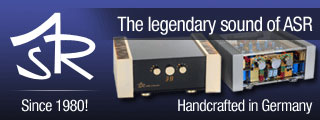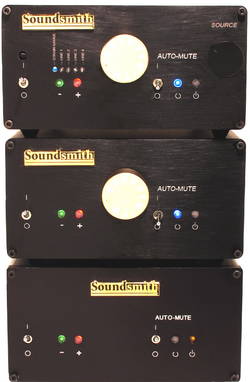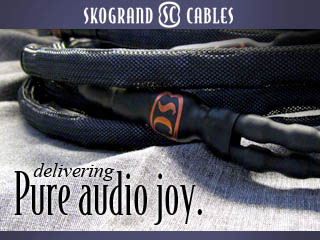Midrange
The Midrange is the glory of an Analogue/SET/Single Driver system. With the SG-220 my system plays voices and instruments in a way that is scary real. It is the midrange that is the glory of this cartridge system and at the same time I find the midrange the most difficult to describe.
First, there seems to be a whole lot more information getting to the speakers and out into the room with this cartridge setup. At the same time, this information seems to be coming into the room in a more natural and relaxed way, that is at the same time incredible dynamics.
Second, yes it has that magic like a great SET system can have, but it goes beyond that; and yes it also has that special way of breathing life into the system, but again it goes beyond that; and yes it is incredible in letting you hear small differences in voices and instruments, but once again it goes beyond that. Lastly, if set up correctly it does have rich harmonic structure, but there is more to its midrange than any of those great things. It simply sounds more alive!
Third, there is an effortlessness to the sound from the lowest bass, through the midrange, all the way to the top end that is just so relaxing to listen to. I’m sure this is a combination of a great 12-inch tonearm and the cartridge, but it is a world beyond anything I have heard before.
So what is it that takes my system to another level with the SG-220 in it? I think you have to go back to what it doesn’t do. It doesn’t ring, vibrate, or in any way smear the sound. The problem with describing this is if you haven’t heard your system with the SG-220, you probably have no idea your current setup is doing this. As good as the Miyabi Standard, the latest Benz Ebony TR, or the Shindo SPU are, and they are really good, they each add a degree of reverb and smearing that I don’t hear with the SG-220. The Benz Ebony TR with its single winding per channel comes closest, but does not have the power or bass that the SG-220 does.
The thing about this quality of what you don’t get is that it brings to life the subtle details you can now hear. For example, listening to Sara K singing and playing an acoustic guitar I hear so much more of her breathing and phrasing. This result in much more like live music. The phrasing is especially hard to get the PRaT right, but it does. Then it also gets the rhythm of guitar playing right along with both the fingering and the decay of the acoustic guitar. It’s quite wonderful.
Treble
My normal test for the top end of an audio system is whether I notice it. If I do then either it is too bright, too etched, or too dull. The SG-220 is none of those, but it is really beautiful. It can be quite delicate, or quite biting depending on what’s on the recording, but it’s the most neutral and most beautiful top end I have heard in my listening room. There is just no way to tell you how good cymbals, recorders, and strings sound.
Soundstage and Scale
Can you say three-dimensionality? Everyone who heard this cartridge said they had never heard such three-dimensionality from recorded music. Yes, my system had a wider and deeper soundstage with this cartridge than ever before, but saying that really misses the point. The soundstage is totally dependent on the recording. It can have a soundstage with great scale, but just as in real life instruments can sound large or sometimes quite small. I bet, like me, you want to hear both. I don’t know why musicians love to walk over and stick their horns right into the mic, but they do and that larger-than-life sound is part of a live Jazz performance. With this cartridge, you get both the scale and the dynamics that occur when they do. That’s what I mean by scale. I want to hear a vocal or a trumpet start soft and small then swell in volume and size as they reach back and let it go.
Another thing I want to hear in a natural soundstage is space and air around, and even within an instrument. I’ve said this before: I don’t want strings floating around in some black velvet space like a modern painting that show strings and notes but no instrument or musician. I want to hear the body of the guitar, I want to hear the floor under the bass, I want to hear the sound of the strings inside a piano. The SG-220 allows my system to do this even better than before. I feel like I’m not conveying how holographic the soundstage is. It is!
Harmonics, Musical Flow, and Texture
After getting the geometry right, the SG-220 was unsurpassed in these areas, but it did require getting the geometry just right. Then I could hear deep into the emotion of the music. This is something that is so important in live music, but rarely heard in recorded music. It allowed my system to draw me deep into the emotions of the music. It did this through all the small nuances that I could hear, but nothing is ever razor sharp, instead it is a beautiful blend of delicacy and dynamics.
For example, can you hear the difference in textures, and harmonics when Willie Nelson or Sinatra sings a song verses some lesser singer singing it.? You can hear and feel the difference in the emotions of a great ensemble playing a number. With the strain gauge in the system, I was simply brought deeper into the emotions of the performance.
How it sounds with and without a separate line stage
Early on, I tried coming out of the fixed outputs of the SG-220 into my Shindo Giscours and then later, I tried this combo again. Don’t get me wrong, it sounds good through the Giscours, better than the Miyabi Standard used with the Homage T1. Playing the strain gauge into the Shindo Giscours, music sounds slightly warmer than going straight into its own preamp, but slower, less transparent, slightly muddy, and the soundstage isn’t nearly as wide, deep, and nowhere near as three-dimensional. You also lose the unbelievable purity you get from it straight into the amp. I can’t imagine why you would not just use the SG-220 straight into your power amp.
There are those of you who will prefer this sound, probably because it’s more like what you are used to. In my system, there was no contest though; I liked it much better straight to my Wavac EC300B. I would go as far as to say if you have only heard it through a line stage, you probably still don’t know how good it is.
Specific Examples
I’ve chosen several of my favorite songs on vinyl and I’m going to talk about how they sound with the SG-220 compared to any low output moving coil I have used with the Shindo Giscours and the Homage T1 SUT.
“Swing Low Sweet Chariot” and “Amazing Grace” from Joan Baez’s album From Every Stage are two songs I always listen to with new equipment. The Soundsmith allowed my system to sound unbelievably alive and open with a holographic three-dimensional soundstage. It had incredible spatial information and an ease about it that made it sound as if Joan Baez was in my listening room.
Listening to Ry Cooder’s great album Jazz, I found it to be a very involving experience. This is the kind of album that highlights transients and harmonics. This was the most delicate, sweetest sound I had ever heard on this LP. It plain sounds prettier on the top-end on many of the cuts on this album. The guitars have such detail and air with rich harmonics, great decay, and such air.
Rob Wasserman’s Duets is one of my favorite albums. I love to hear the standup bass played well and Wasserman’s bass playing is superb. My favorite cut is Wasserman and Jennifer Warnes’ version of “Ballad of the Runaway Horse”.
Pop, Pop, Rickie Lee Jones’ iconic album is another that I always use to evaluate equipment. On this album, Rickie Lee’s vocals can get a little shrilled, but not with all cartridges. The detail, information, and soundstage on this LP are also superb.
Tracy Chapman’s iconic debut album Tracy Chapman is a struggle for some playback systems. Her voice has such power and edge, it’s not easy to get this right without sounding edgy or even mistracking in some places. The SG-220 sailed through this LP with such powerful effortlessness and emotion that it was hard to tear myself away from it. I ended up listening to the entire album on four different evenings. The power of the bass and her voice combined with the guitars was mesmerizing.
Neil Young and Crazy Horse’s album Americana shows another strength of this cartridge, it’s ability to play loud, grungy rock music. Up until now, the two best cartridges I had heard for rock music were the EMT JSD5 Jubilee and the London Reference. Both of these cartridges have tons of balls and slam. Where the Soundsmith SG-220 surpasses these two cartridges is in its ability to play those guitar riffs and all the other grungy rock sounds without sounding grungy itself. It unravels those sounds in a way that is lifelike and it has more power and slam than I had heard on my system.
I could go on and on but let me end by talking about the Mercury Living Presence LP HI-FI A LA ESPANOLA. I have listened to this album since my college days. The dynamics, which range from an almost silent ‘pianissimo’ to thundering Crescendos, are incredible and I have never experienced them like I did with this setup. I could hear and feel the full power of the orchestra like never before and the bowed basses is an emotional experience. As the performance reaches its climax, each instrument maintains perfect clarity and definition as I have never heard on any system.
- ← Previous page
- (Page 3 of 4)
- Next page →




I’ve been fortunate enough to have owned a Strain Gauge cartridge for nearly 2 years now. Whilst your review may appear as an uncritical gushingly positive review, it is in concordance with my own experience. All I would add to your review is to emphasise how well the SG presents musical timbre, it isn’t just drums that sound like real drums, all instruments are presented with a natural life-like timbre.
The other interesting observations with this cartridge are:
That some LPs that sounded terrible with my previous cartridge (ZYX Airy 3) now sound great, but also vice versa.
Part of what is different is the incredibly low noise floor, I never realised how noisy MC cartridges were until I didn’t have one.
Mono albums sound great with this cartridge, nobody else had mentioned this before – I thought that it was just me!
It was interesting that you mentioned the Decca London, I had an original Garrott Brothers modified Decca and this has been the cartridge that I’ve enjoyed the most until I bought the Strain Gauge.
Thanks Prof for reading the review and it’s great to hear that you have had the cartridge for two years and still loving it. To me that says it all. It’s not uncommon for people to love a new purchase and with time to feel it wasn’t as good as they thought.
Thank you so much for your comments and I agree with your comments about the timbre of instruments. Now that I’m just listening to music and not reviewing it I am enjoying it even more.
Dear Mr. Roberts,
I completely agree with you about the Strain Gauge principle. Almost fifty years ago, as a student, I got the opportunity to help to build the Euphonics Miniconic System. The Design was straightforward. We had two problems; first because of the construction, one of the two channels needed an
inverter-stage (At that time we had only some Ge-transistors and no differential-amplifiers!). The second problem was the choice of the best
material for the suspension.
Fortunately, at NASA in Houston, they stock an enormous choice of different rubbers. We decide to use a natural butyl-rubber… They were endless discussions about the influence of the rubber in the resulting aesthetic of the sound!
Now, I am still using the Euphonics, together with the SG RAM preamp that Peter Ledermann designed for the Matsushita SG at RAM Audio. About wearing? From my own experience, no problem after 45 years of use. I had some trouble at the beginning, not because of the SG, they were already very reliable (NASA used them to test the deformations on the Polaris-rockets) but the contacting between the small epoxy SG-holder and the outside world was very poor. On my system, I took out the contacts, just soldering four tiny wires direct on the epoxy.
About my sound experience; I had plenty of carts (MM-Shure, MC-Dynavector, etc) I still prefer the sound of the SG. It gives me fantastic dry bass and crystal clear high frequencies. I connect Mr. Ledermann’s RAM preamp direct to the power amplifier. Especially if you use Direct Disc Records (Sheffield Labs, Three Blind Mice) you get a near reality sound experience!
Now, as a retired engineer, I hope that I will raise enough money to afford the SG-220.
I hope I was not disturbing you too much with my stories. Thank you very much for your engagement for the survival (or revival) of the
SG-principle. A system responding to the displacement (amplitude) will be, for me, always better than one using the derivative of the signal (velocity)!
I send you my best regards
Dr. Yves Lehareinger
P.S. Almost 50 years ago, I got the same feeling as you, discovering Peter Walker’s wonderful ELS 57!
Many years ago I, for a short while owned a Win SG. As I have heard here, I’m recalling a not so subtle difference in the reality presented with the strain guage. It’s startling.
On the opening of one of my favorite albums, Better Days by Paul Butterfield, there is a short dialogue. “OK Nick” I believe one of the band members says. My dog Lea jumped up, although she had heard the album many times. Closest to reality of any medium of reproduction I’ve ever heard. One day sir, one day I’ll have one.
Peter’s miraculous Strain Gauge has been my reference cartridge since 2011 and is used each week by to dub vinyl sources for my web show “The Vinyl Experience.” I concur with all of the observations of this comprehensive review. It sounds neither analog or digital, but rather like a unique window into original sources. I too have wrangled the joys and sorrows of the quirky London Decca line of cartridges and find the SG to absolutely be a ‘Decca that actually tracks,’ a unicorn in the Hi Fi woods if there ever was one. Most significantly, our glowing little blue creature is it’s own animal, and a brilliant reflection of it’s creator and his own clear values. The cautionary words about geometry and set-up are well advised–I’ve lived with mine for nearly a college-career of years and I’m still tweaking. This is a cartridge that rewards a well-balanced system of components that get out of the way, and that includes simplifying all aspects of set-up. If your tonearm eschews goofy little things like height or azimuth adjustment or wiggle room in those headshell slots, you’re sunk. A Soundsmith Strain Gauge demands it, and delivers rewards in proportion to the effort expended. It’s a tweaker’s cartridge, and proudly so. The great thing about vinyl: if you just want to “never mind the bollocks’ and simply play records, you can spend hundreds-not thousands-and get bang for buck with wonderful new things like (for instance) Rega’s P1. But if tweaking is the whole idea, and peeling the layers of the audio onion your great pleasure, every penny spent on the SG will come back to you in glorious dollops of obsession.